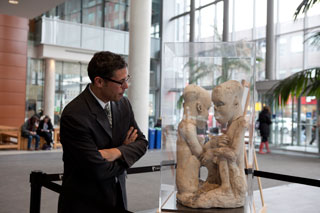Comments on sculpture mystery
Thanks to national media coverage, millions of Canadians learned more about the artifact, <em>The Starving of Saqqara.</em>
April 6, 2011
|
- On the Ottawa Citizen website, Paul Von Ward commented: “What struck me was the resemblance of the elongated skulls with Andean-region mummies in the museum at Nazca in Peru. Does that suggest early cultural ties?”
- An anonymous Ottawa Citizen reader hypothesized: “Looks like Nubians: Fantastic piece. I don't see the issue with this piece at all; rather fortunate to have a limestone piece in this condition. The man's head shape really looks Masai (semi-nomadic people in Kenya and Tanzania), while the woman's looks like Amhara (an ethnic group in central Ethiopia). These could possibly be slaves from further south; perhaps they were part of a band that made it across the Sahara only to be ‘rescued’ by the Egyptians and immortalized in stone because of their unusual anatomical features. Very interesting piece.”
 Concordians inspect The Starving of Saqqara displayed in Atrium of Engineering, Computer Science and Visual Arts Integrated Complex. | Photos by Concordia University
Concordians inspect The Starving of Saqqara displayed in Atrium of Engineering, Computer Science and Visual Arts Integrated Complex. | Photos by Concordia University
- On CBC.ca, Elizabeth Reid wrote: “I find this sculpture intriguing for a number of reasons. It has two individuals, sitting side by side and interacting, but not in a normal face to face manner. One has his eyes almost closed and his mouth almost closed — although his teeth are showing — and he is holding the other individual's arm."
"The other's eyes and mouth are open. He appears to be singing or possibly chanting. His hand is holding his ankle. His mouth and teeth are carefully carved and his tongue is visible. The sculptures are treated in a stylistic fashion, with the exception of the mouths, to which is given particular detail, almost as if the artist modeled it after a mouth in real life. From the mouths I think we can surmise an African origin. As for the purpose of this sculpture, I wonder if it might be depicting a ritual."
"Perhaps the individual with partially closed eyes is ill — which in ancient times could be equated with bad spirits — and these spirits are being exorcised from his body by the other individual, possibly a witch doctor, by singing or chanting. It is unusual for prehistoric sculpture to depict interaction between two individuals, but this would not necessarily discount the distinct probability that it is prehistoric.”
- Another CBC.ca reader pondered: “Saqqara is an ancient necropolis of ancient Egypt, which has tombs from various periods. Some ancient cultures buried their dead in a seated, or fetal, position with knees up against the chest, in a burial vessel or jar, and more than one individual could have been buried in one vessel. At first glance, these bodies look somewhat disproportionate, with large heads compared to the smaller limbs. It could be that this may be a ‘final’ sculpture (something akin to a death mask) of deceased. Glad to see my alma mater reaching out to the public on this.”
 The Starving of Saqqara features inscriptions from a seemingly ancient language.
The Starving of Saqqara features inscriptions from a seemingly ancient language.
- On the Diniacopoulos webpage, Dorota Kozinska shared the following: “The first thing that struck me about the sculpture was how familiar it was to me. As an art critic, I have seen hundreds of images, so perhaps it’s no wonder, yet this was more of a ‘blink’ moment. I have also lived in the Middle East (Syria), so the possibility of seeing a similar work of art is very high. The second thing that moved me was the sculpture’s emotional component. This is a beautiful work of art, at once ancient and unnervingly contemporary." Another Diniacopoulos webpage visitor posited: “The head structure/physiology of the two individuals reminds me of a Rockefeller collection sculpture of a fetish piece from the Sundi of Zaire. That particular one was of wood, but the heads really seem of the same peoples.”
- A reader from the archeology magazine Past Horizons commented: “There're East Africans who resemble these figures to this day. They're incredibly ectomorphic — bony (or characterized by long and thin muscles/limbs and low fat) — and only appear 'starving' compared to, say, Westerners. They're also incredibly lithe and effortlessly sit bolt upright on the ground without needing the least support for their backs, their knees tucked closely into their chests, their hands casually wrapped 'round their ankles like loose bracelets, making most Westerners who try to copy them feel prematurely geriatric!”
 Clarence Epstein, Concordia's Director of Special Projects and Cultural Affairs, examines The Starving of Saqqara.
Clarence Epstein, Concordia's Director of Special Projects and Cultural Affairs, examines The Starving of Saqqara.
- “(The sculpture is) most likely representations of conquered captives, who are frequently represented in early Egyptian art naked, seated, in lines, and frequently bound by ropes around the necks. Although no ropes are represented in the carving, these may have been displayed originally with actual ropes attached,” related another Past Horizons reader.
- “It's gorgeous. I'm floored. His hand on her forearm in such a tender way, with great familiarity. The flaws add to the perfection. I want to talk about each in detail. I hope we never learn more about it,” marveled a YouTube viewer.
Related links:
• CSI Montreal: Concordia sculpture investigation, NOW, March 15, 2011
• Diniacopoulos Collection